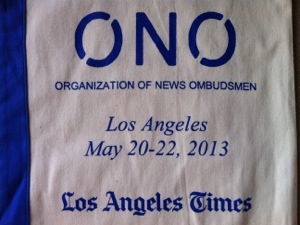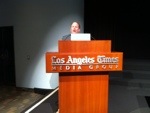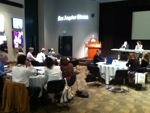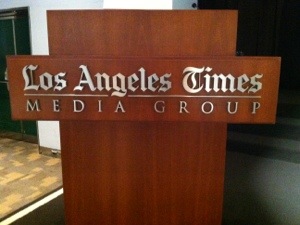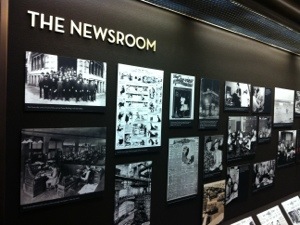
Veteran Turkish journalist Yavuz Baydar, our fellow ombudsman, was fired from his long-time post at the Sabah daily on Tuesday, after its editorial board censored two of his columns related to the Gezi Park protests and media-government relations. – a shocking news to all of us, that first of all shows, that ombudsmen have to keep on fighting in order to reach their goals, to uphold the freedom of the press. And it also shows, how important media ombudsmen are in our democracy!
Kirk LaPointe, Executive Director, Organization of News Ombudsmen (ONO), was guest-speaker and delivered a impressive speech at the recent World Journalism Educators Congress in Belgium. The photo (left) shows the annual ONO-conference in Los Angeles in May 2013.
Read his speech:
„Thank you for the invitation today. I am grateful for the privilege to speak to you and share the stage with two such distinguished keynote speakers.
I do teach part-time as an adjunct professor in journalism at University of British Columbia, so I am not entirely a fish out of water here. But I am here, after a quarter-century of managing media, representing the Organization of News Ombudsmen.
ONO is our acronym. It is also the sound many news managers make when they learn an ombudsman is about to investigate a public complaint. Actually, ONO would be one of the more polite things they say.
Many journalists liken the experience of an ombudsman’s review to being summoned to the principal’s office or to an afternoon in the dentist’s chair. Or to an intervention for a substance abuse issue. Certainly nothing nice. It tells us quite a bit about journalism that it might be considered that way.
I want to talk today a little bit about the role, a bit about what we’re seeing, and a few suggestions about the situation. I want to refrain from too much prescription.
ONO comprises about 70 or so ombuds, public editors, and reader representatives, whose role it is to be public advocates when complaints arise and issues surface in media coverage — which is to say, every hour of every day from all over concerning all things. We also have as associate members those who examine and teach in the broad area of media ethics and public engagement.
Complaints come in all sizes and shapes. No two are ever alike, are even addressed or resolved alike, because their contexts differ. The situated knowledge of one is not the situation knowledge of another, so there can be differing approaches to the same complaint in various parts of the world to reflect local sensibilities. It is a role, after all, with common sense in mind.
There is precious little scientific analysis about complaints, but the basic data indicate complaints are most often about accuracy. People don’t like it when they think something wrong is being spread. And they have long since become whip-smart at identifying and not tolerating error. They want a correction, a retraction, an apology if possible.
But increasingly these days, the complaints are about fairness and the methods journalists use to gather and present. Even when the content is provided free, people feel free to question it: the perceived irresponsibility, the emphasis they wish were accorded the story, the significant missing element, or the effort that would have, in their minds, brought equitability.
The complaints are very sophisticated in many cases, posing real challenges retroactively to the decision-making, second-guessing the judgment, calling into question the way in which professionals acted. If there is any doubt the public is smarter than the newsroom, the nature of complaints should dismiss that concern.
People are wondering why journalists aren’t taking our own medicine. They hate it if we don’t respond — in the electronic age, everyone else seems to respond — and hate it even more if we respond with the same spin that might come from a politician or big business. They feel their loyalty is betrayed if you talk down to them. And they are merciless if the conversation feels less than authentic.
To be an ombudsman is to accept that even a broken clock is right twice a day. You know you need to leave the job when you conclude that a broken clock is wrong 23 hours and 58 minutes. It is a job for the patience of Job. When all around are reverting to child-like behavior, the ombudsman is the wise elder. While others are talking and pointing fingers, the ombudsman is the model of discretion and deliberation.
The role is part organizational moral compass, part guidance counsellor. The realm of the ombudsman isn’t supposed to be one of unrealistic or magical thinking. It’s to be practical, to help newsrooms live up to realistic public expectation and to help the public understand the realities — including the deficiencies — of the craft of journalism.
With each complaint, there is effectively a winner and a loser. Your ultimate loyalty as an ombudsman is to the public. But at its best, the role serves as the proverbial, somewhat clichéd, honest broker with an ability to use objective methods of inquiry and to be direct with each party once a finding is reached.
When I talk to other ombuds — there are women and men, so the title is perhaps due for a touch-up — what they tell me is that they’re noticing differences in the nature and tone of the complaints in recent times.
They perceive a greater impatience and more harshness in the mix lately. It’s as if the public is itself exhausted with overwork, admitting it, and wondering why overworked journalists can’t just admit it, too. In other words, why can’t they be human? Why do they need to defend and justify the indefensible justification?
At a time many newsrooms are shedding costs, I am pleased to note that our membership is growing, particularly in Europe and Asia, where there have been several recent appointments and interest among media to create the role. This is a hopeful sign, although having dozens in a field of thousands is considering the glass’ fill and not its emptiness.
That said, some media are recognizing that they need a mechanism to reassure the public. They view the ombudsman or a public editor or a similar office as a form of quality assurance to its audience, albeit one with limitations, and part of a reputation management system embedded in its governance. Depending on the mandates, these ombudsmen have significant latitude to proactively and reactively represent the public’s complaints, moods, inclinations and instincts — and, unlike other critiques, to propel a response.
The ombudsmen numbers are declining in North America, with the most recent example being the elimination of the role at the Washington Post and its appointment of a reader representative with a far less formidable mandate. As news organizations in North America shed legacy costs, this function is seemingly more at risk there than anywhere.
ONO has existed since 1980. I am new in this role as Executive Director, but it is our hope we can enlarge the organization in years to come. I would encourage you in this room to join as associate members, to help us with your insights.
For good reason. We think the role is needed. We think it serves a wide array of public interests. We even think it benefits the media’s business interests.
I am in a room of journalism educators, so I am not telling you anything new to note that academic research has consistently found about one in two stories contain factual errors, that media trust in most countries has been in decline, that state and special-interest pressures can discernibly sway journalism, and that newsrooms are prone to be defensive in their culture and much less transparent than the institutions they cover and from whom they expect it. Many institutions could well say to journalism: Physician, heal thyself. These are all matters you discuss in your classrooms, as we do at University of British Columbia.
Particularly in an era of media abundance, it should make sense that creating and enforcing high standards would enhance and entrench one’s reputation, would signal an accessible and accountable news organization, and would even serve as a point of differentiation with an increasing number of competitors.
After all, a form of oversight does not have to be oversized. It can push for higher standards, but mainly it simply holds an organization to its commitments, usually those reflective of the Society of Professional Journalists’ code of ethics: to tell the truth, to minimize harm, to act independently, and to seek accountability of others and of themselves. Of course, with the devil in the details, we know these are no small matters.
Yet in some organizations, the mere thought of this oversight is overbearing. It is deemed an intrusion, an indulgence, an intervention, or an interference. I suspect this response hasn’t likely changed since the origins of the ombudsman concept back in the Qin Dynasty in China, circa 200 BC.
Some news managers consider the marketplace the best barometer of their behaviour — that is, if they misbehave, consumers will turn elsewhere. We know this isn’t always so.
Others believe that the laws, particularly those on defamation, serve to keep a news organization in line. We know, too, that this isn’t so, that not everyone wants to or even can wage a legal fight, and that not all unsuccessful legal cases are without their merits. That clearing a name or a reputation or even basic information need not be a struggle in the courts or even a cat-and-mouse chase.
Still others note the letters to the editor, online story comments, and even the blogosphere as more than ample checks on their journalistic fairness and accuracy.
We know that these voices, while often helpful, can only go so far in representing the public because they have no invested authority. There are no professional or organizational requirements to hear them, to investigate them, to make a determination on them, and to act upon them. Independent criticism only has so much effect.
It is fair to say that in a time of cost-cutting, an ombudsman can appear an easy target or an unwise investment economically. As one editor put it recently: “I can choose to have an ombudsman or a health reporter.” We know this is a false choice, but it is an example of what some cite.
These reasons not to have oversight are justifications borne out of some fear, an oblique concession of vulnerability, and some determination that admission of error constitutes a weakness rather than a virtue.
Some organizations do not like the attendant publicity that comes with an ombudsman’s finding, feeling it provides an opportunity for their competitors to crow about a mistake when those competitors do not subject themselves to that same institutional scrutiny and publicity.
I don’t particularly agree with the justification, but in many ways I understand it. Ombudsmen — and those who advocate high standards of journalism, like those in this room — do not always make a persuasive argument. We appear to have an old sound in an era of constant newness. If you listen to pop music, you’ll know that approach may work for Daft Punk, but not us.
I learned some time ago that we human beings have three basic needs: to be seen, heard and understood. Think about it: Those three needs cover everything in our lives. Our work, our relationships, our sense of well-being and self-esteem are housed in that concept. But these needs — seen, heard, understood —- do not necessarily carry into how journalism engages its audience.
This is curious for a business that so seeks to satisfy, that so wants to serve, that so enjoys reveling in fanfare, that is all about show and tell and share and discuss. How can it be that a craft would at all wish to isolate itself from those who attend loyally to its work, who pay the bills, who spread the word — and would not make every effort to see, hear and understand its audience?
What I’ve learned is that people don’t necessarily need to be agreed with. They really only need to be acknowledged. An ombudsman, or a facsimile, is media’s best effort to recognize those needs, to listen to the audience, understand its support and criticism without a change in blood pressure either way. And to help an organization contend with the collision of two cultures: the one that wants openness, the one that prefers not.
Two things strike me as curious in this current context of media.
First, for legacy media, I wonder why more haven’t created the position of ombudsman or public editor as they have transformed the business into a digital-first operation. As they shed all of these resources and remake their processes, I wonder why they did not see the need for a form of public insurance on their standards — a position or a mechanism that would ensure that standards and practices evolved and didn’t suffer along the way. I wonder if that might prove an immense regret later.
Second, for digital media, I wonder why few if any are creating a similar position. For all of the glory of the new age, are we failing to explain how standards are evolving and being upheld? Crowdsourced content can work, but crowdsourced complaint resolution isn’t workable. Audience engagement can work, but audiences are not enabled to investigate a complaint thoroughly. So, something has to emerge here — if not an ombudsman role, then a new process. If it doesn’t, I also think that will prove an immense regret.
To have the strongest debate on journalism and its future, we need more players in the tent to be transparent and accountable. Because we are in need of many debates that digital media can guide.
Now, there are also responsibilities for the ombudsmen here to demonstrate their value. I want to discuss two areas of work here: One we can prove, one we need to go about proving.
The first argument, the easier one, is actually about economics and it might appeal to the bottom-line-oriented manager. An ombudsman can save an organization a lot of money and an immense amount of managerial and reportorial time that can be better spent.
In one newsroom I managed, where we didn’t have an ombudsman, we used to note that our highest-paid person on the payroll was our legal counsel. Our lawyer had to deal with countless complaints, mainly about fairness and accuracy, that stood little or no chance of making it into the courts but nonetheless occupied time and resources. He constantly had to send off an expensive letter to keep the wolves at bay. And for every billable moment of the lawyer there was often a sunk and frittered cost of newsroom resources to work through the complaint.
Most ombudsmen very tidily handle the vast majority of these public complaints at a fraction of the expense. I wouldn’t go so far as to say they are self-liquidating, but in some cases it can be close. The presence of an ombudsman gives the public a legitimate and reliable alternative to the courts, a guarantee of a public airing of a complaint, an investigation, a deliberation, a presentation — and ultimately, better information upon which the public can then determine.
What we can only guess at economically is what an active ombudsman saves in terms of complaints that don’t arrive or in reputations in the community that might keep subscriber or advertiser support in place. The presence of an ombudsman reassures the public someone is there on watch.
A second issue, though, is one worth greater study. Does the presence of an ombudsmen or public editor or reader representative have a direct relationship to the public trust in that organization? Certainly, many of the most trusted brands feature this function: The New York Times, the BBC, PBS, many of the European media, among them.
But the correlation isn’t necessarily causation, and we need empirically to examine the connection between the presence of an ombudsman and public trust. We think it’s there, and we need that evidence as part of our effort to create a constituency. That constituency will lead organizations to better practices, which will better serve their interests and those of the public.
What are the messages here for educators? Well, first off, it’s clear that in examining the quality of journalism, ombudsmen have found that a conversation works better than lecture, so that is our contribution if your instincts are similar.
You know your students are heading into a pace of production and change you did not experience. The challenge I see is one we contend with at UBC: what my wife, a most respected academic, identifies as how to provide intellectual readiness in journalism graduates, so that they are prepared for whatever conditions they encounter or decisions face them.
Part of that intellectual readiness is a grasp of the theory and practice of ethical decision-making. In part this is acknowledgement of reality: that in this technologically determinist time of gadget-driven journalism without ombudsmen or public editors in their midst, journalists might otherwise be left — no pun intended — to their own devices.
If our next wave of journalists will be more entrepreneurial, less tied to organizations, more personally branded, more portable and agile, then what grounds them is of vital importance because they may not have the same mentored relationships in their networks, the same continuity of learning in an organization, or even the same forgiveness of errant decisions.
It makes professional, economic and social sense to get this understanding at the front end of a career, not learn it the hard way along the way. If we are lucky, they will emerge as ethical entrepreneurs. Even if their organizations won’t appoint ombuds or substantially train newsrooms, then they can at least be schooled to do the right thing, make the best choices, and develop a greater sense of reflexivity in how they report.
While, from my admittedly self-serving perspective, we need more ombudsmen, if we can’t have them, the next best thing is to teach our journalists to think and act like them.
Thank you.“














